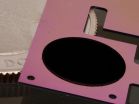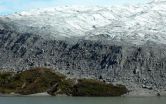(Press-News.org) Reducing the level of mutant p53 gene increases susceptibility to treatment
Scientists from the National Cancer Centre Singapore (NCCS) have discovered the workings of the gene that has been hindering treatment response in cancer patients. This discovery was made after 5 years of studying the mutant form of the p53 gene, the major tumor suppressor in humans, which is generally found mutated in over 50% of all type of human cancers.
The dominant-negative (DN) effect of the mutant p53 gene in cancers was found to affect the outcome of cancer treatment modalities. DN effect is a phenomenon whereby one copy of mutant p53 that exists in cancer cells inhibits the tumor suppressor activity of the other wild-type p53 copy when they co-exist. The result is that a patient may either have poor response or earlier relapse of tumours after their treatment.
The research findings is significant in that it offers hope to improve cancer treatment outcomes by selectively inhibiting mutant p53's DN effect through several methods by generating selective and specific inhibitory molecules specific for some of the common hot-spot p53 point mutations. There are currently no drugs or compounds that can alleviate DN effects of mutant p53.
In order to understand the specific roles of mutant p53 DN properties in regulating acute treatment response and long-term tumourgenesis, a team of five researchers led by NCCS Prof Kanaga Sabapathy, the Principal Investigator in the Laboratory of Carcinogenesis and Head of the Division of Cellular & Molecular Research from NCCS, carried out experiments by generating genetically engineered knock-in mouse strains expressing varying levels of mutant p53. The results showed that DN effect is observed after acute p53 activation by a variety of chemotherapeutic drugs and irradiation, thereby affecting anti-cancer treatment. This breakthrough came after five years of intensive research.
It was found that mutant p53 have DN effects in a cell-type and dose-dependent manner, especially during acute p53 activation where p53 levels are elevated. Based on the above observations, efforts to generate specific inhibitors for the common hot spot p53 point mutations are underway. The inhibition of mutant p53 expression in cells carrying a wild-type and mutant p53 alleles can improve response to chemotherapeutic drugs.
In a further study, the researchers also questioned the possibility of the mutant p53 acquiring new functions (or Gain of Function) to drive carcinogenesis, transforming normal cells to cancerous cells. Their investigation comparing cells from genetically engineered mouse strains expressing 2 different types of p53 mutations: the R172H mutation versus the R246S mutation, which showed that Gain of Function (GOF) was found only in the former. This showed that GOF of mutated p53 is specifically dependent on mutation-type but not across all kinds of genetic mutations, highlighting diversity in properties of the different types of p53 mutations, thereby indicating that mutations found in human cancers can behave differently, and thus, need to be carefully assessed prior to treatment.
Thus, the existence of mutant p53 certainly has a negative impact on cancer treatment, whether it is through DN effect or GOF. Prof Sabapathy said that the team is now embarking on more research to determine the possibility of targeting mutant p53 without affecting wild-type p53 in human cells, paving way to clinical trials in the future to test the efficacy on cancer therapeutic response.
### The research was supported by grants from the National Medical Research Council of Singapore and the Singapore Millennium Foundation to KS. The publication has been accepted and published by Cell Press, publisher of biomedical journals, in the premier cancer journal Cancer Cell, on 10 Dec 2012, Monday. Prof Sabapathy also teaches at the Duke-NUS Graduate Medical School.
National Cancer Centre Singapore scientists discover p53 mutation hinders cancer treatment response
2013-01-25
ELSE PRESS RELEASES FROM THIS DATE:
Evolution inspires more efficient solar cell design
2013-01-25
The sun's energy is virtually limitless, but harnessing its electricity with today's single-crystal silicon solar cells is extremely expensive — 10 times pricier than coal, according to some estimates. Organic solar cells — polymer solar cells that use organic materials to absorb light and convert it into electricity — could be a solution, but current designs suffer because polymers have less-than-optimal electrical properties.
Researchers at Northwestern University have now developed a new design for organic solar cells that could lead to more efficient, less expensive ...
Quantum communication: Each photon counts
2013-01-25
This press release is available in German.
The detector combines near-unity detection efficiency with high timing resolution and has a very low error rate. The results have been published by Nature Communications (doi:10.1038/ncomms2307).
Ultrafast, efficient, and reliable single-photon detectors are among the most sought-after components in photonics and quantum communication, which have not yet reached maturity for practical application. Physicist Dr. Wolfram Pernice of the Karlsruhe Institute of Technology (KIT), in cooperation with colleagues at Yale University, ...
NIST's 'nanotubes on a chip' may simplify optical power measurements
2013-01-25
The National Institute of Standards and Technology (NIST) has demonstrated a novel chip-scale instrument made of carbon nanotubes that may simplify absolute measurements of laser power, especially the light signals transmitted by optical fibers in telecommunications networks.
The prototype device, a miniature version of an instrument called a cryogenic radiometer, is a silicon chip topped with circular mats of carbon nanotubes standing on end.* The mini-radiometer builds on NIST's previous work using nanotubes, the world's darkest known substance, to make an ultraefficient, ...
Analysis of Greenland ice cores adds to historical record and provide glimpse into climate's future
2013-01-25
A new study that provides surprising details on changes in Earth's climate from more than 100,000 years ago indicates that the last interglacial--the period between "ice ages"--was warmer than previously thought and may be a good analog for future climate, as greenhouse gases increase in the atmosphere and global temperatures rise.
The research findings also indicate that melting of the massive West Antarctic ice sheet may have contributed more to sea-level rise at that time than melting of the Greenland ice sheet.
The new results from the North Greenland Eemian Ice ...
Emotional stress reduces effectiveness of prostate cancer therapies in animal model
2013-01-25
WINSTON-SALEM, N.C. – Jan. 25, 2013 – Not surprisingly, a cancer diagnosis creates stress. And patients with prostate cancer show higher levels of anxiety compared to other cancer patients.
A new study by researchers at Wake Forest Baptist Medical Center indicates that stress is not just an emotional side effect of the diagnosis; it also can reduce the effectiveness of prostate cancer drugs and accelerate the development of prostate cancer.
The findings are published in the February issue of the Journal of Clinical Investigation.
The Wake Forest Baptist team, headed ...
INRS develops a nanohybrid with remarkable properties using a new laser-plasma process
2013-01-25
Montreal, January 25, 2013 – By achieving the synthesis of a novel nanohybrid structure by means of the pulsed laser ablation (PLA) technique, Professor My Ali El Khakani and his team paved the way for a new generation of optoelectronic materials. The combination of carbon nanotubes and lead sulfide (PbS) nanoparticles was performed using an effective and relatively simple process that offers considerable latitude for creating other nanohybrids for a variety of applications. The INRS Énergie Matériaux Télécommunications Research Centre researcher's work, published in the ...
No more 'empty nest:' middle-aged adults face family pressure on both sides
2013-01-25
CORVALLIS, Ore. – The "empty nest" of past generations, in which the kids are grown up and middle-aged adults have more time to themselves, has been replaced in the United States by a nest that's full – kids who can't leave, can't find a job and aging parents who need more help than ever before.
According to a new study by researchers at Oregon State University, what was once a life stage of new freedoms, options and opportunities has largely disappeared.
An economic recession and tough job market has made it hard on young adults to start their careers and families. ...
New tool for mining bacterial genome for novel drugs
2013-01-25
Vanderbilt biochemists have discovered that the process bacteria undergo when they become drug resistant can act as a powerful tool for drug discovery.
Their findings – reported this week in the Online Early Edition of the Proceedings of the National Academy of Sciences – should give a major boost to natural products drug discovery – the process of finding new drugs from compounds isolated from living organisms – by substantially increasing the number of novel compounds that scientists can extract from individual microorganisms.
Bacteria have traditionally been the ...
New suite of chemicals seen causing disease generations later
2013-01-25
PULLMAN, Wash.—Washington State University researchers have lengthened their list of environmental toxicants that can negatively affect as many as three generations of an exposed animal's offspring.
Writing in the online journal PLOS ONE, scientists led by molecular biologist Michael Skinner document reproductive disease and obesity in the descendants of rats exposed to the plasticizer bisephenol-A, or BPA, as well DEHP and DBP, plastic compounds known as phthalates.
In a separate article in the journal Reproductive Toxicology, they report the first observation of cross-generation ...
Breast feeding okay for mothers taking immunosuppressant drug
2013-01-25
Highlights
The breast milk of mothers taking the immunosuppressant tacrolimus contains only very low levels of the drug.
Women taking tacrolimus who wish to breast-feed after appropriate counseling should not be discouraged from doing so.
Increasing numbers of pregnant women are taking tacrolimus after organ transplantation and for other conditions.
Washington, DC (January 24, 2013) — Women taking the immunosuppressant tacrolimus can rest assured that breast feeding will not elevate their babies' exposure to the drug, according to a study appearing in an upcoming ...


